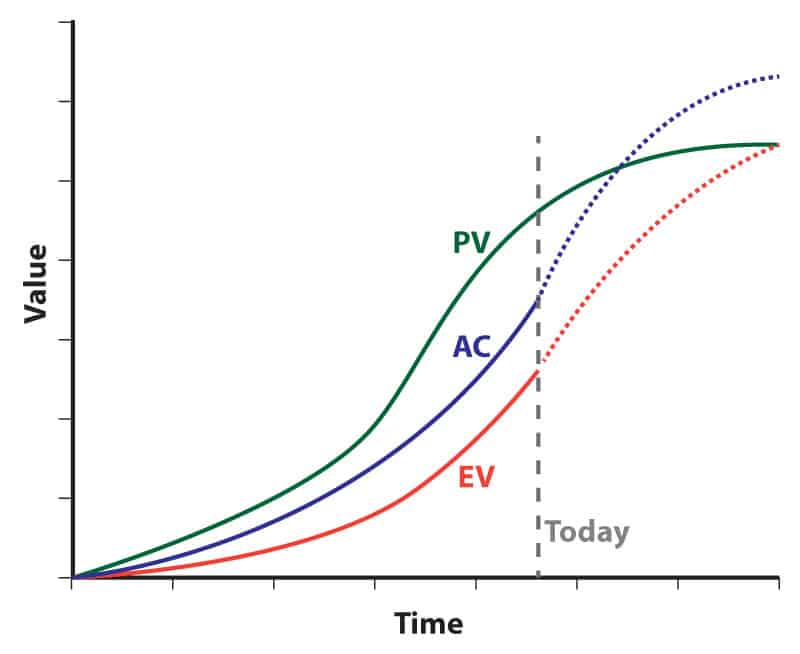PMP Earned Value Management (EVM) Calculation Explained in Simple Terms
A simplified discussion of the EVM calculation just enough for the PMP Exam

Summary: Among all the PMP Exam formulas calculation questions, the Earned Value Management (EVM) questions are usually considered the most important ones as candidates will need to solve quite a few of them in the real PMP Exam — I got around 5+ EVM questions on my PMP Exam paper and I am quite confident that I could get them all correct.
However, many project managers may not have done any EVM in their projects and many of them consider the EVM questions a bit scary. This post aims to help PMP aspirants to understand easily the EVM concepts and how to tackle the EVM questions.
Article Highlights
Introduction
PMP Earned Value Management (EVM) questions are difficult? Or easy?
As project managers come from different backgrounds, there is no consensus for the level of difficulty of EVM questions. But if you can understand the concepts of EVM firmly, you too will find that EVM questions for the PMP Exam is indeed NOT difficult at all. After all, the PMP Exam is not an exam decided for Maths students, the PMP Exam tests your understanding of project management as a whole.
Download the full list of PMP Exam formulas for Free
To arrive at the correct answers for EVM questions, all you need to do in the PMP Exam is to:
- Read the question carefully
- Select the correct formula to apply
- Calculate the answer (this is often the easiest part! You can get most answers without the use of calculators)
 Additional free PMP resources: 20+ free practice questions (with answer explanations) on PMP EVM to help Aspirants practise EVM skills. Wish you PMP success!
Additional free PMP resources: 20+ free practice questions (with answer explanations) on PMP EVM to help Aspirants practise EVM skills. Wish you PMP success!PMP EVM Concepts Explained With Examples
Earned value management (EVM) is used to assess the schedule and cost performance of a project — with EVM, the project manager will know exactly whether the project is:
- ahead of / on / behind schedule
- under / on / over budget
Earned value management (EVM) bases on the concept that i) work completed will deliver value and ii) the value delivered equals the budget put into the work. The value gained can be assessed along the progression of the project. In reality, earned value management is very complicated as value usually cannot simply be assessed based on the percentage of completion.
Good news here: PMI has simplified PMP EVM calculation to very “ideal” situations! You will just need to know the following to get your PMP EVM questions correct.
Basic EVM Formulas
To speak more clearly how the value is to be managed, a number of terms are defined in EVM (explained with the example of building 10 houses each has a value of US$1000 expected to be completed in 10 weeks in proportion):
- Planned Value (PV) — The budgeted value of the work completed so far at a specific date
example: at end of week 4, altogether 4 houses should be completed, the PV is US$4000 - Earned Value (EV) — The actual value of the work completed so far at a specific date (refer to the “Notes on Earned Value Measurement” section below)
example: by end of week 4, only 3 houses are completed, the EV is US$3000 - Actual Cost (AC) — The total expenditure for the work so far at a specific date
example: by end of week 4, US$4000 was spend, the AC is US$4000
EVM is based on monitoring these three aspects along the project in order to reveal the health of the project with the following indices:
- Schedule Variance (SV) — difference between PV and EV, to tell whether the project work is ahead of / on / behind schedule
- SV = EV – PV
If the project is behind schedule the SV will be negative (i.e. achieved less than what planned)
If the project is on schedule the SV = 0
If the project is ahead of schedule the SV will be positive (i.e. achieved more than what planned) - example: by end of week 4, the SV = EV – PV = US$3000 – US$4000 = -US$1000 (behind schedule)
- SV = EV – PV
- Schedule Performance Index (SPI) — ratio between EV and PV, to reflect whether the project work is ahead of / on / behind schedule in relative terms
- SPI = EV/PV
If the project is behind schedule the SPI < 1 (i.e. achieved less than what planned)
If the project is on schedule the SPI = 1
If the project is ahead of schedule the SPI > 1 (i.e. achieved more than what planned) - example: by end of week 4, the SPI = EV/PV = US$3000/US$4000 = 0.75 (behind schedule)
- SPI = EV/PV
- Cost Variance (CV) — difference between EV and AC, to tell whether the project work is under / on / over budget
- CV = EV – AC
If the project is over budget the CV will be negative (i.e. achieved less than spent)
If the project is on budget the CV = 0
If the project is under budget the CV will be positive (i.e. achieved more than spent) - example: by end of week 4, the CV = EV – AC = US$3000 – US$4000 = -US$1000 (over budget)
- CV = EV – AC
- Cost Performance Index (CPI) — ratio between EV and AC, to reflect whether the project work is under / on / over budget in relative terms
- CPI = EV/AC
If the project is over budget the CPI < 1 (i.e. achieved less than spent)
If the project is on budget the CPI = 1
If the project is under budget the CPI > 1 (i.e. achieved more than spent) - example: by end of week 4, the CPI = EV/AC = US$3000/US$4000 = 0.75 (over budget)
- CPI = EV/AC
Note both SV and SPI / CV and CPI give similar information on schedule / budget but the indices will give more insights into the actual performance with a meaning comparison.
From my experience, the most difficult process of solving EVM problems for PMP Exams is to identify the PV, EV and AC from the wordy calculation questions. Then you will just have to recall the correct formula to substitute the values into to get the answer — the question will usually ask you directly about the actual indices to get.
Advanced EVM Formulas
- Budget at Completion (BAC) — also known as the project/work budget, that is the total amount of money originally planned to spend on the project/work
- example: the BAC for the housing project = US$1000 x 10 = US$10000
- Estimate at completion (EAC) — as the project goes on, there may be variations into the actual final cost from the planned final cost, EAC is a way to project/estimate the planned cost at project finish based on the currently available data
- The following formulas can be used to calculate EAC based on which information and conditions given in the question:
- EAC = BAC/CPI
If we believe the project will continue to spend at the same rate up to now- The delay is caused by reasons which is likely to continue (e.g. labour with less skilled than expected)
- example: the EAC for the housing project = US$10000 / 0.75 = US$13333
- EAC = AC + (BAC-EV)
If we believe that future expenditures will occur at the original forecasted amount (no more delays of the same kind in future)
- The delay might be caused by some unforeseen reasons (e.g. typhoon) which is not likely to happen again
- example: the EAC for the housing project = US$4000 + (US$10000 – $3000) = US$11000
- EAC = AC + [(BAC-EV)/(SPI*CPI)]
If we believe that both current cost and current schedule performance will impact future cost performance- The performance of the project will continue with sub-prime standards (over budget and behind schedule)
- This formula is less likely to be used for the PMP Exam
- example: the EAC for the housing project = US$4000 + [(US$10000 – $3000)/(0.75*0.75)] = US$16444
- EAC = AC + New Estimate
If we believe the original conditions and assumptions are wrong- Will not be tested as there is nothing to calculate
- EAC = BAC/CPI
- The following formulas can be used to calculate EAC based on which information and conditions given in the question:
- Variance at Completion (VAC) — the variance at completion, i.e. the difference between the new estimate at completion and original planned value
- VAC = BAC – EAC
If we forecast the project will be over budget, VAC will be negative
If we forecast the project will be under budget, VAC will be positive - example: the VAC for the housing project = US$10000 – US$13333 (just take the 1st EAC as an example only) = -US$3333
- VAC = BAC – EAC
- To Complete Performance Index (TCPI) — the efficiency needed to finish the project on budget, it is the ratio between budgeted cost of work remaining and money remaining
- TCPI = (BAC-EV)/(BAC-AC)
Use this equation if the project is required to finish within BAC- example: the TCPI for the housing project at end of week 4 = (US$10000 – US$3000) / (US$10000 – US$4000) = 1.167
- TCPI = (BAC-EV)/(EAC-AC)
Use this equation if the project is required to finish within new EAC- example: the TCPI for the housing project at end of week 4 with new EAC US$13333 = (US$10000 – US$3000) / (US$13333 – US$4000) = 0.75
- TCPI = (BAC-EV)/(BAC-AC)
Notes on Earned Value Measurement
The following will discuss how earned value is measured for project and work, from simple physical measurements, percentage complete to weighted milestones. Since the PMP EVM questions cannot describe a lot of information, the part on earned value measurements will normally be based on simplified situations like physical measurements or percentage complete.
It is likely that you will not be tested on the more difficult ways of measuring earned values. These are included here for your reference only.
- Physical Measurement — directly transform the physical measurement of the amount of work completed into EV
- example: building 10 houses each has a value of US$1000 expected to be completed in 10 weeks in proportion, earned value of 3 house built is US$3000
- Percentage Complete — directly transform the percentage of the amount of work completed into EV
- example: building 10 houses each has a value of US$1000 expected to be completed in 10 weeks in proportion, earned value of 30% complete is US$3000
- Weighted Milestone — a EV is assigned to the 100% completion of each milestone of the work packages with prior agreement with stakeholders
- Fixed Formula — a specific percentage of the overall PV is assigned to the start of a work package and the remaining assigned upon completion; these must be agreed upon in the project management plan
- 0/100 rule: 0% EV at the activity begins; 100% EV upon completion
- 20/80 rule: 20% EV at the activity begins; 80% EV upon completion.
- 50/50 rule: 50% EV at the activity begins; 50% EV upon completion
EVM Charts
In common practices, EVM will also involve plotting the values on a graph in order to help stakeholders concerned to visualize the progress and the health of the project. More often than not you will find the EV, AC and PV plotted on a graph and you will be asked on the interpretation of the graph.
Insights to be gained from the chart:
- If EV line is below PV, the project is behind schedule; if EV is above PV, the project is ahead of schedule.
- If AC line is below EV, the project is within budget; if AC is above EV, the project is over budget.
Below is an example of the EVM charts you would be likely to encounter in your PMP Exam — solid lines represent actual figures while dotted lines represent forecasted figures:

Judging from the chart above, we can infer that the project is currently over budget and behind schedule.
PMP Earned Value Management (EVM) Formulas in PMBOK® Guide At a Glance
| Name (Abbreviation) | Formula | Interpretation |
|---|---|---|
| Schedule Performance Index (SPI) |
SPI = EV/PV EV = Earned Value |
< 1 behind schedule = 1 on schedule > 1 ahead of schedule |
| Cost Performance Index (CPI) |
CPI = EV/AC EV = Earned Value |
< 1 Over budget = 1 On budget > 1 Under budget sometimes the term ‘cumulative CPI’ would be shown, which actually is the CPI up to that moment |
| Schedule Variance (SV) |
SV = EV – PV EV = Earned Value |
< 0 Behind schedule = 0 On schedule > 0 Ahead of schedule |
| Cost Variance (CV) |
CV = EV – AC EV = Earned Value |
< 0 Over budget = 0 On budget > 0 Within budget |
| Estimate at Completion (EAC) if original is flawed |
EAC = AC + New ETC AC = Actual Cost |
if the original estimate is based on wrong data/assumptions or circumstances have changed |
| Estimate at Completion (EAC) if BAC remains the same |
EAC = AC + BAC – EV AC = Actual Cost |
the variance is caused by a one-time event and is not likely to happen again |
| Estimate at Completion (EAC) if CPI remains the same |
EAC = BAC/CPI BAC = Budget at completion |
if the CPI would remain the same till end of project, i.e. the original estimation is not accurate |
| Estimate at Completion (EAC) if substandard performance continues |
EAC = AC + [(BAC -EV)/(CPI*SPI)] AC = Actual Cost |
use when the question gives all the values (AC, BAC, EV, CPI and SPI), otherwise, this formula is not likely to be used |
| To-Complete Performance Index (TCPI) |
TCPI = (BAC – EV)/ BAC = Budget at completion TCPI = Remaining Work BAC = Budget at completion |
< 1 Under budget = 1 On budget > 1 Over budget |
| Estimate to Completion |
ETC = EAC -AC EAC = Estimate at Completion |
|
| Variance at Completion |
VAC = BAC – EAC BAC = Budget at completion |
< 0 Over budget = 0 On budget > 0 Under budget |
Additional Resources
After understanding the above and memorizing the EVM formulas, PMP aspirants should be able to answer PMP EVM calculation questions. Now it is time to test your understanding of EVM calculation by going through some practice questions at the article tips and skills on how to answer all PMP EVM questions correctly — 20+ practice questions on PMP EVM are also included to help you hone your EVM skills and all questions are fully explained.
Most Popular PMP Certification Exam Articles
- My Exam Prep Tips and Free Resources (I got 4P and 1 MP)
- How to Get 35 Contact Hours Fast and Easy?
- Detailed Comparision of online PMP Courses
- Over 1000+ FREE Quality Mock Exam / Practice Questions
- A FREE Guide to Formulas and Calculation (with explanation and sample questions)
- 47 Commonly Confused Terms with detailed explanation




 Hi, my name is Edward Chung, PMP, PMI-ACP®, ITIL® Foundation. Like most of us, I am a working professional pursuing career advancements through Certifications. As I am having a full-time job and a family with 3 kids, I need to pursue professional certifications in the most effective way (i.e. with the least amount of time). I share my exam tips here in the hope of helping fellow Certification aspirants!
Hi, my name is Edward Chung, PMP, PMI-ACP®, ITIL® Foundation. Like most of us, I am a working professional pursuing career advancements through Certifications. As I am having a full-time job and a family with 3 kids, I need to pursue professional certifications in the most effective way (i.e. with the least amount of time). I share my exam tips here in the hope of helping fellow Certification aspirants!






Any one who can help me with this thing please ???
1) An artist agreed to prepare portraits of 100 celebrities
in 200 days at a price of $500 per portrait. Fifty days later,
artist finished 21 portraits with an actual total cost of
$11,400. What is the status of the Project? Specify your
answer by making all possible EVA (Earned Value
Analysis) calculations ????
2Assume that you wanted to develop and install ten
printer drivers with total Budget of $100,000 ($10,00 per
printer driver) within budgeted time of 10 weeks (1 printer
driver per week). Assume also that you have developed
and installed 4 printer drivers by spending $47,500 to
date. What is the status of the Project? Specify your
answer by making all possible EVA (Earned Value Analysis)
calculations ?
Good day, very interesting site. I see that right frame overlap with the main text. Could you please correct this? it is very hard to read the main text. I am using chrome. At this page line with words “Summary: Among all the PMP® Exam formulas calculation questions, the …” overlap with “wish you the certification success”. I may send you the screen short via e-mail if you need it for the troubleshooting
BR, Dmitry
Sorry for that, my bad. I have since amended the technical error. Please refresh the browser to view the update. Thanks for your support!
I as well would like to use this page to present to my PMI chapter study group.
Of course the material will not be reproduced anywhere else
Sure, please just share the URL to your group members, thanks!
Wish you PMP success!
Thanks for the PMP stuff, very useful
So glad you find my blog on PMP useful!
Great examples, thanks for sharing! Earned Value Management is really useful when the project management team needs to monitor the performance of the project. Thanks to EVM, certain project schedule and budget performance issues can be avoided. Cheers!
Paul – HUSH Project Management & Consulting Limited
Thanks Paul for your comments!
Just a question out of curiosity… the PV calculates completion at a specific date (in the example above at week 4 it is planned that 4 houses are complete) but my PMP book says that work packages rarely require the same amount of budget and they give the example of building a pyramid each level has a different number of stones to be laid.
The budget is $1M and you have 1 year to build it. At the end of Q1 levels 1 and 2 will be (planned) done; Q2 levels 3 to 5; Q3 levels 6 to 8; and Q4 levels 9 to 10. The percent planned to be completed at Q1 is 9%; Q2 is 30% complete; Q3 is 66% complete; and Q4 is 100%.
I just want to know how these percentages were determined? Would this planned completion come from scheduling or from resources planned?
Hi Monet,
Thanks for your query. Sorry that with such information, I am not able to understand how such percentages were determined. Maybe it is determined by the construction company in view of the labour & material supply and the construction conditions?
Anyway, wish you PMP success!
Thanks Edward for the info! Very helpful.
So, I have seen this formula as well a couple of times; EAC = AC + {(BAC-EV)/CPI}.
When is this used and is it in anyway an almost similar situation to EAC=BAC/CPI ?
Yes, you are right. However, I seldom see this formula.
Please correct the “Cost Variance (CV) — difference between PV and AC” to “Cost Variance (CV) — difference between EV and AC”, its difference between Earned vale and Actual Cost.
Hi Syed,
Thanks a lot for pointing out such an obvious mistake. That’s my bad.
Wish you PMP success!
Hi Edward – Firstly, thank you for creating this one stop shop for PMP related content.. super helpful!!
I am preparing for PMP certification. As am doing sample questions through different websites, I noticed several questions on motivational theories..however I don’t find any such reference in 6th edition/ Are these valid for 6th edition or are these primarily from previous versions?
Yes, motivational theories were included in PMBOK Guide 5th edition. Nonetheless, as the PMP Exam is more than the PMBOK Guide, it is better to learn more than what is included in the PMBOK Guide just in case. (I actually encountered several questions asking knowledge containing in the previous versions of PMBOK Guide in my PMP Exam.) Plus, you may need to understand these theories for team management for your own benefits.
Wish you PMP success!
This is a great article. Clear and concise. Thanks!
Thanks for your comment.
Wish you PMP success!
Hi Edward,
I have a question regarding the Time Value chart on this page. I thought AC < PV = under budget. Below the chart, it's stated the project is over budget, based on comparing it against the EV. Should we compare AC against PV or EV ?
Well, as this is earned value management, we focus on EV more often.
According to the definition, when AC < EV, that would be under budget. Wish you PMP success!
hi, thanks so much for sharing the information.
I have a question in calculation, should EV = BAC x completed unit / total unit?
Following is the question:-
produce 12 units with budget of $60M in 12 months. At fourth month, five units is produced and AC is $25M. What is the CPI and project status?
I think EV = 60M x 5/12 (as completed 5 units) = 25M
CPI = EV / AC = 25/25 = 1 => on budget (is that correct? but no answer can be chosen for this).
Many thanks
Yes, I agree with you that the EV can be calculated pro rata for liner project deliverables. The CPI should be 1 while the SPI is larger than 1 as the project is ahead of the schedule.
Wish you PMP success!
I passed my exam yesterday. Thanks so much for your sharing, they are very useful!
Hello. Can you please let me know if AOA is a start to finish relationship or a finish to start relationship? Also are both AOA and AON precedence diagramming methods or is it only AON that is a precedence diagramming method? Lastly is precedence diagramming method one of the components of a project schedule network diagram?
Both AOA and AON are just different ways of showing the precedence relationship of the activities (they are some examples of project schedule network diagrams). I usually make use of AON rather than AOA as the presentation is much clearer (maybe just my personal preference).
Wish you PMP success!
Hi Mr. Chung, This is a fantastic resource page. I wish I found it sooner! I am going to be taking the PMP exam March 26th 2018. Do you have any advise that might be helpful as far as the new exam material goes? I have studied mostly from the 5th edition PMBOK. I do have a copy of the 6th edition PMBOK and I understand they are going to be adding Agile material? Thanks, John Reed, Ch.E.
Hi John,
Most of my study notes have been revised to include 6th edition materials. You can refer to them for the updates. And the formulas on this page are still relevant.
Wish you PMP success!
Thank you for the valuable articles
If allowed to highlight the inefficiency of EVM in tracking the project performance
Yes, for some project EVM may be inefficient. But for others, EVM is a great way to tell the progress and performance. It is a mater of application.
Wish you PMP success!
Thank you very much for the valuable information
Hi Edward,
Please guide how can i get the downloadable pdf version of this article?
Thanks in advance.
Cheers
Hi MF,
You may use the “print” function of the browser and save as PDF. Thanks!
Wish you PMP success!
Hello Edward, your site is very helpful. Thanks for the time and effort you’ve spent in putting it together. I already sat and passed the PMP exam in 2013, but I find that there are some things that I don’t use so they fade from my memory over time, and I always have to revisit the subject. Earned value is one of them because my company does not use it. I only recently discovered that there is a certification called Earned Value Professional (EVP) offered by AACE International. Their site is http://www.aacei.org for anyone who is interested. For those people who are analysts or project controllers, a strong grasp of earned value is priceless! Thanks for your work!
Thank you so much! I am getting ready for an intensive boot camp but math is not my thing at all. Your examples are helping me to begin to make sense of the formulae.
Thanks a lot for your encouraging words. I really hope my sharing would be useful to fellow PMP Aspirants.
Wish you PMP success!
Dear Edward, thanks a ton. I have cleared my PMP exam in first attempt on 30th August 2017. Your tips helped me lot.
Congratulations! You should be very proud of your achievements!
Hi Edward,
First of all, its a great source of information for the Beginners to Experts. I am afraid whether there is a Typo in the inferring the graph
“Judging from the chart above, we can infer that the project is currently over budget and behind schedule”.
If the AC is Below PV, I assume it should be under budget.
2. Is this correct? If AC line is below EV, the project is within budget; if AC is above EV, the project is over budget. Or a typo?
Yes, this chart is quite confusing indeed (as I was also not quite sure of the answers in the beginning).
In judging whether a project is over budget, we will just have to consider the AC vs EV. If AC > EV, it is over budget. If EV > AC, it is under budget. PV is used to judge whether the project is proceeding according to the schedule or not (i.e. ahead or behind the schedule).
You may refer to the formulas below:
・Cost Performance Index (CPI) – CPI = EV/AC
・Schedule Performance Index (SPI) – SPI = EV/PV
Wish you PMP success!
hi.
great article, but i’m a little bit confused. if EAC=AC+BAC–EV then VAC is equal to CV, cause VAC=BAC–EAC (VAC=BAC-AC-BAC+EV=EV-AC=CV). so there is no point in calculate VAC, or am i wrong in something?
Yes and no. You are right under a special circumstance — the EAC=AC+BAC–EV formula is applied when BAC remains the same (i.e. the variance is caused by a one-time event and is not likely to happen again and the project would proceed exactly as planned). In this case, CV at the time would be equal to the estimated VAC. But if the event has a long lasting effect on the project performance, CV at that time would NOT be equal to the new estimated VAC and other EAC formulas would apply in such case.
Wish you PMP success!
Hi Edward,
I am taking a class to earn my project management certification. I would like to get your permission to use the EVM chart above for one of my assignments. I understand EVM better because of your explanation. Thanks
Sure if that’s for your assignment, but please don’t republish it online. Thanks!
Great article!
Another typo: TCPI states 1.67 but should be 1.167
Thanks a lot for pointing out the typo, my bad. I have it amended in no time.
Wish you PMP success!
Hi Edward, I have a question regarding one of your formula interpretation. In the VAC formula (VAC = BAC – EAC) you are interpreting 0 result as being over budget. Should not it be the other way round ? If BAC is less than EAC (<0 result) it means that project is over budget, isn't that so ? Apologies, if I misinterpreted.
Hi Anas,
If BAC is less than EAC, it means that at current stage the total cost estimated is less that what was planned at the beginning of the project, so the project is under budget, and vice versa. Hope this helps.
Hi,
great explanation; but I think there is a confusion between “cost” and “value” in this explanation.
Let me try to explain myself: in example above the reference to each house value of $1K seems to be the “price” the house will be sold at (so the revenues), but then the AC is associated with the cost to build the houses: 3 houses built = $3K of cost (so the cost of the task/project).
I think EV should refer to “cost to deliver”; in the example above this could be:
1 house estimated cost = $1K
planned houses at today = 4, –> planned cost at today = $4K (PV)
actual delivered houses at today = 3 –> EV = $3K
actual cost to deliver 3 houses = $3.5K (AC)
And so the CPI and SPI should be:
CPI = EV/AC = 3K/3.5K over budget
SPI = EV/PV = 3K/4K behind schedule
or am I missing something? 🙂
Hi Andrea,
You bring a new perspective in considering the “Value” in “Earned Value Management”. But, according to the norms, the “value” is usually defined as the “budgeted cost” in Earned Value Management.
Thanks!
Thanks a lot sir. I was not confident which formula to apply while solving problems on EAC. But now I can creep out which conditions are required to be analysed. Thanks once again.
Regards,
Sandipan Chakraborty
Assistant Engineering Manager
Larsen and Toubro Limited
Mobile no. +919830301488
✌
In the “insights to be gained” from the EVM chart, it says “If AC line is below PV, the project is within budget”. Then below, it says it can be inferred that the project is over budget. On the chart, it shows the AC line below the PV line. Would it be within budget or over budget? Is it within budget today but forecasted to be above budget later? Thank you.
Hi Brian,
Thanks a lot for pointing out the typo. When judging whether the project is over or under budget, we use the EV vs AC instead of the PV. I have corrected the typo above. Thanks!
The same about the example: by end of week 4, the CV = EV/AC = US$3000/US$4000 = 0.75 (over budget).
Should be CPI.
Hi Constantine,
Thanks a lot for spotting the typos!
Wish you PMP success!
Hi Edward,
There is another typo in the example:
the SV = EV/PV = US$3000/US$4000 = 0.75 (behind schedule)
Instead of SV should be SPI.
Hello, very nice article!
One note though: regarding the SPI = EV/PV the example you give:
You wrote:
example: by end of week 4, the SPI = EV/PV = US$3000/US$4000 = 0.75 (behind schedule)
Thats NOT correct.
The project is NOT 0.75 behind schedule —the project is 75%(0.75) done and ONLY 25% (0.25) behind schedule.
Hi, it seems the commentary you’ve added on the EVM is incorrect ? It looks like the project is over budget as of “today”.
Thanks for your comment. The typo has been amended.
Hi Radka,
Thanks for pointing out the typo. I have amended the post to correct the VAC calculation. Wish you PMP success!
Regards,
Edward